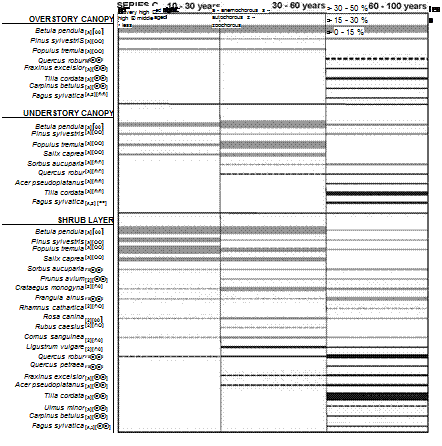Further data (FLB 2003; Tischew et al. 2004) were included to integrate woodland development into general colonization processes on soil dumps. Ordination methods or results from permanent plots were used to determine site factors (e. g. pH values, soil textures, diaspore sources) that could work as “switch points” within successional dynamics (Fig. 6). Based on these results and on the development of complex successional networks, it is possible to predict general developmental tendencies in eastern German post-mining landscapes. Depending on the diaspore sources in the direct
 |
Fig. 5. Frequency of selected pioneer, intermediate and climax tree species in shrub as well as upper and lower tree layers in three age-classes (10-30 years, 3060 years, 60-100 years) of the successional series C, with information about dispersal modes and light requirements in different life stages
Fig. 6 (next page) Successional scheme for primary succession in eastern German post-lignite mining landscapes on sites distant from groundwater (groundwater depth > 2 m)
|
||
|
||
|
||
|
||
|
||
 |
||
 |
||
|
||


surroundings, species that arrive first on hospitable sites determine the vegetation structures on these sites (right-hand side of the diagram). Initial colonization patterns are also influenced by the availability of so-called safe sites (e. g. small depressions accumulating water and a little organic material). These initial patterns lead to secondary patterns by the mechanisms of “facilitation” or “inhibition” among the already established species and the newly immigrated species, and can vary a lot (patch-dynamics concept, Wiegleb and Felinks 2001; Prach 1987). Differentiation processes of species based on site factors become clear in older successional stages. On extreme sites, the influence of stochastic effects is, in principle, smaller due to selection for species that can tolerate these site factors (e. g. extremely low pH values, very wet or very dry soils). Vegetation development is impeded mainly on dry and extremely acidic sites (left-hand side of the diagram), where successional stages free of trees are expected over longer periods.


